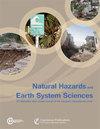评估空间扩散——遥感观测综合洪水图的技巧
IF 4.7
2区 地球科学
Q1 GEOSCIENCES, MULTIDISCIPLINARY
引用次数: 0
摘要
摘要一组预测洪水淹没地图有可能表示洪水预测的不确定性,并提供特定位置的洪水可能性。综合洪水地图预报为洪水预报员、洪水风险管理人员和保险公司提供概率信息,并最终使生活在洪水易发地区的人们受益。综合洪水图预测与远程观测洪水的空间验证对于理解综合预测的技能和单个综合成员洪水图的变化或扩展所代表的不确定性都很重要。在大气科学中,尺度选择方法已被用于评估对流降水集合预报。这通过在一系列长度尺度上局部计算技能度量来确定合奏性能的技能尺度(一致性尺度)。通过将这种方法扩展到一个新的应用程序中,我们评估了感兴趣领域的整体洪水预测的空间可预测性和空间扩散技能。空间扩散-技能方法在每个网格单元计算每个唯一的集合洪水图对(集合空间扩散)之间以及每个集合洪水图与SAR衍生洪水图之间的一致比例(集合空间技能;SAR:合成孔径雷达)。将这两者进行比较,以产生最终的空间扩散——技能表现。这些方法应用于2017年8月印度阿萨姆邦布拉马普特拉河的洪水事件。空间技能和扩散-技能关系都随位置而变化,并可能与洪水事件的物理特征有关,如强降水的位置。在运行预测系统中监测洪水淹没准确性的过程中,空间扩散-技能关系的验证和映射将允许更好地量化预测系统的偏差和不确定性。这对于预测流量未经校准的未计量集水区尤其有用,并将使预测链的不同部分能够进行有针对性的模型改进。本文章由计算机程序翻译,如有差异,请以英文原文为准。
Assessing the spatial spread–skill of ensemble flood maps with remote-sensing observations
Abstract. An ensemble of forecast flood inundation maps has the potential to represent the uncertainty in the flood forecast and provide a location-specific likelihood of flooding. Ensemble flood map forecasts provide probabilistic information to flood forecasters, flood risk managers and insurers and will ultimately benefit people living in flood-prone areas. Spatial verification of the ensemble flood map forecast against remotely observed flooding is important to understand both the skill of the ensemble forecast and the uncertainty represented in the variation or spread of the individual ensemble-member flood maps. In atmospheric sciences, a scale-selective approach has been used to evaluate a convective precipitation ensemble forecast. This determines a skilful scale (agreement scale) of ensemble performance by locally computing a skill metric across a range of length scales. By extending this approach through a new application, we evaluate the spatial predictability and the spatial spread–skill of an ensemble flood forecast across a domain of interest. The spatial spread–skill method computes an agreement scale at every grid cell between each unique pair of ensemble flood maps (ensemble spatial spread) and between each ensemble flood map with a SAR-derived flood map (ensemble spatial skill; SAR: synthetic aperture radar). These two are compared to produce the final spatial spread–skill performance. These methods are applied to the August 2017 flood event on the Brahmaputra River in the Assam region of India. Both the spatial skill and spread–skill relationship vary with location and can be linked to the physical characteristics of the flooding event such as the location of heavy precipitation. During monitoring of flood inundation accuracy in operational forecasting systems, validation and mapping of the spatial spread–skill relationship would allow better quantification of forecast systematic biases and uncertainties. This would be particularly useful for ungauged catchments where forecast streamflows are uncalibrated and would enable targeted model improvements to be made across different parts of the forecast chain.
求助全文
通过发布文献求助,成功后即可免费获取论文全文。
去求助
来源期刊
CiteScore
7.60
自引率
6.50%
发文量
192
审稿时长
3.8 months
期刊介绍:
Natural Hazards and Earth System Sciences (NHESS) is an interdisciplinary and international journal dedicated to the public discussion and open-access publication of high-quality studies and original research on natural hazards and their consequences. Embracing a holistic Earth system science approach, NHESS serves a wide and diverse community of research scientists, practitioners, and decision makers concerned with detection of natural hazards, monitoring and modelling, vulnerability and risk assessment, and the design and implementation of mitigation and adaptation strategies, including economical, societal, and educational aspects.

 求助内容:
求助内容: 应助结果提醒方式:
应助结果提醒方式:


